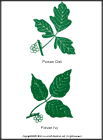
Poison Ivy, Poison Oak, and Poison Sumac
Brief Version
What is poison ivy, oak, and sumac?
Poison ivy, poison oak, and poison sumac are plants that are found throughout North America. They all cause the same type of skin rash. More than 50% of people are sensitive to the oil of these plants. The rash usually lasts 2 weeks. Your child probably has touched one of these plants if:
- There is an area of skin with extremely itchy streaks or patches of redness and blisters.
- A rash appears 1 or 2 days after being in a forest or field.
How can I take care of my child?
- Wash the skin.
If you think your child has had contact with one of these plants, wash the exposed skin with any soap as soon as possible.
- Cool soaks to reduce itching.
Soak the area with the rash in cold water or massage it with an ice cube for 20 minutes as often as necessary.
- Steroid creams.
Apply a steroid cream to reduce the itching. Your child's cream is ________________________. Put the cream on the area with the rash ___ times a day for ___ days.
- Benadryl.
If itching persists, give Benadryl orally (no prescription needed). Your child's dose is ___________________. Give it every 6 hours as needed.
- Contagiousness.
The fluid from the sores themselves cannot spread the rash. However, the oil or sap from the plant can cause the rash for about a week and may remain on a pet's fur or on items such as shoes or clothes. Wash it off pets or clothes with soap and water.
How can I help prevent poison ivy, oak, or sumac?
Everyone should wear long pants and socks when walking through woods that may contain poison ivy, oak, or sumac.
Call your child's doctor during office hours if:
- The itching becomes very bad, even with treatment.
- The skin looks infected (you see pus or soft yellow scabs).
- The rash lasts longer than 2 weeks.
- You have other concerns or questions.

